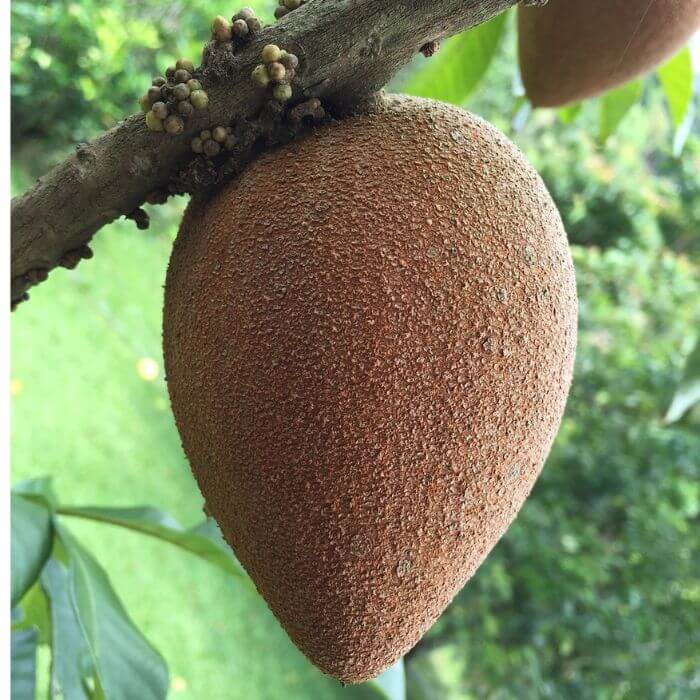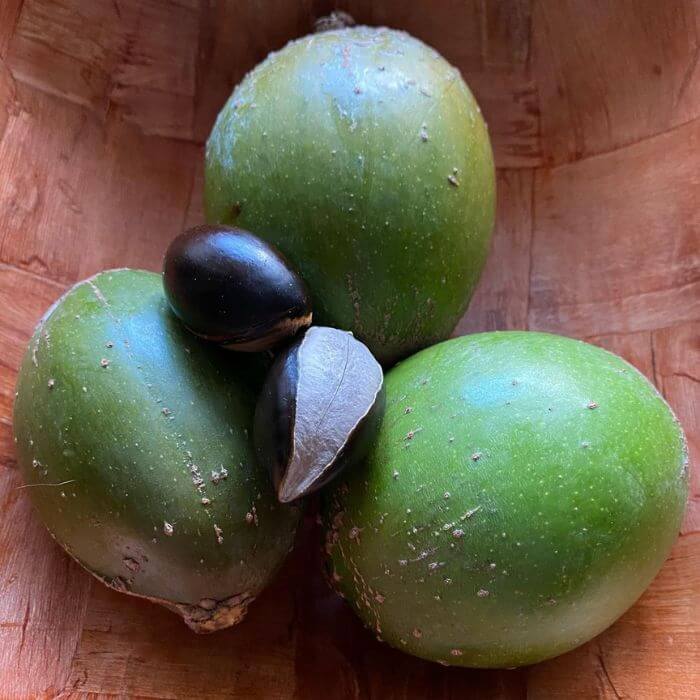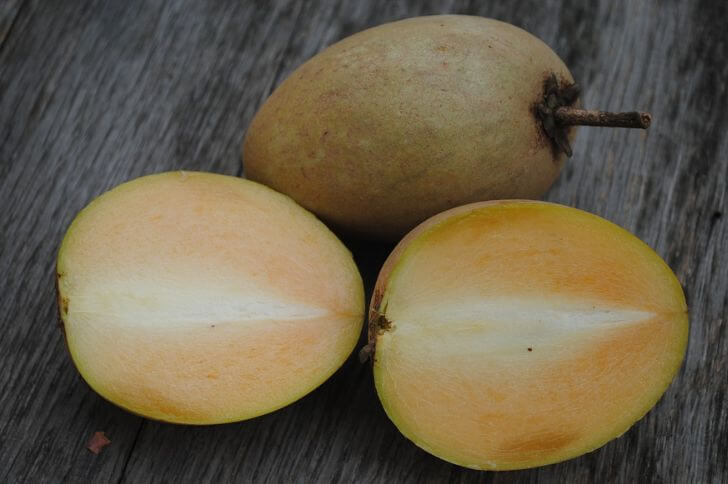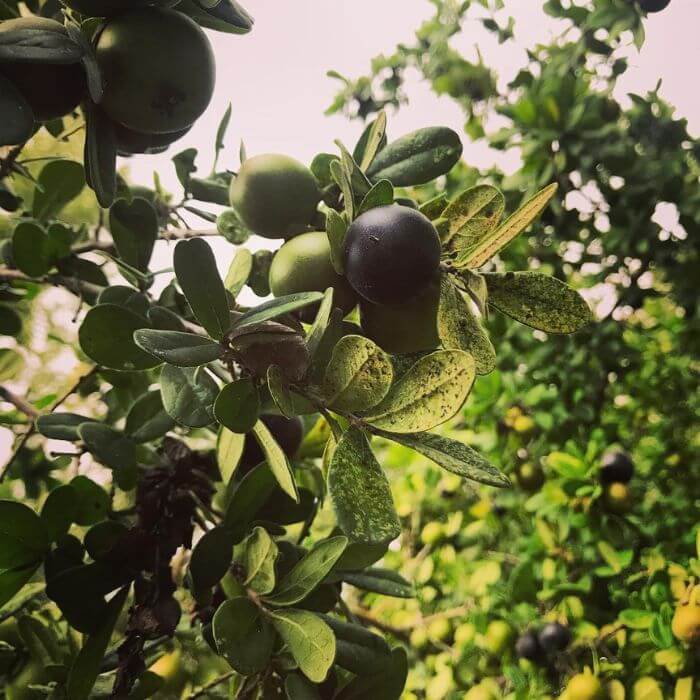Sapote fruits are delicious and exotic tropical fruits that are found in various parts of the world.They have a unique flavor and an interesting texture, making them a favorite among many people.
Although there are different types of sapote fruits, they all share similar characteristics such as being nutrient-dense and packed with vitamins and minerals.
In this article, we will explore sapote fruit varieties that exist and their distinct features. Whether you’re a first-time sapote eater or someone who loves to indulge in its sweetness, this article will provide you with comprehensive information on this tropical fruit.
Types of Sapote Fruits
1. Black sapote

Black sapote is a fruit that belongs to the family of persimmons. It is also known as chocolate pudding fruit or zapote prieto due to its appearance and taste.
Appearance:
Black sapotes are easy to identify. They have a round shape, similar to a tomato, and grow up to 11 inches in diameter. When it ripens, its skin turns from green to dark brown or almost black.
The flesh of the black sapote looks like chocolate pudding and has a mild, sweet flavor. The texture is soft and creamy, which makes it perfect for desserts such as ice cream, smoothies or pies.
What do black sapotes taste like? The smooth flesh tastes like a mix of cocoa and caramel.
Overall, this exotic fruit offers a unique culinary experience due to its appearance and taste. It’s easy to use in recipes as an alternative ingredient for chocolate lovers who want something healthier yet still satisfyingly sweet.
2. Mamey sapote

Another common sapote variety you can enjoy is the mamey sapote.
Appearance:
Found in Central America as well as the Caribbean, mamey sapotes look nothing like their cousins above. But that does not mean they are hard to identify.
This fruit has a brown, rough exterior that can be tough to peel due to its softness. Its interior is soft, creamy, and bright orange (salmon) in color. The flesh of the mamey sapote has a sweet flavor, often compared to sweet potatoes with hints of caramel and brown sugar.
Mamey sapotes are often used in desserts, such as ice creams, or in smoothies because of its rich flavor and creamy texture.
It can also be eaten raw or used as an ingredient in savory dishes such as sauces or salsas.
Mamey sapotes can also be fried.
Note, its seeds are also useful. They contain oils used in making beauty products.
3. White sapote fruits

source:ez2plant.com
Also known as Mexican apples or casimiroa, white sapotes are another type of sapote fruit that originate from Central America and Mexico.
Appearance:
White sapote belongs to the family of citrus fruits. They are closely related to limes and grapefruit and have yellowish-green skin. Its shape ranges from round to oval with a diameter between 1.9-3.9 inches.
When you cut open a white sapote, you will find creamy white flesh with 2-3 seeds inside. The texture of the flesh can be compared to that of custard or avocado – smooth and creamy.
What do white sapotes taste like? I’d compare its taste to peach or banana.
Due to its unique flavor and texture, this small fruit is gaining popularity among food enthusiasts around the world. It can be eaten fresh, added to smoothies or desserts.
4. Yellow sapote

source: growingyourgreens
Yellow sapote belongs to the Sapotaceae family. It is known by different names; egg fruit, canistel, and zapote amarillo.
It is native to Central and South America, but it is also grown in other parts of the world such as Australia, Hawaii, and Florida.
Appearance:
The fruit is about the size of an orange or grapefruit and has a yellow-green skin that turns yellow when ripe. The flesh inside is bright yellow and has a custard-like texture.
Yellow sapote has a sweet flavor. Its taste can vary depending on its ripeness – when fully ripe, it tastes like a pumpkin pie.
This yellow fruit can be eaten raw or made into juice or smoothies for a refreshing drink. Some people also use it in making sorbet due to its rich creamy texture.
Lesser known Sapote Varieties
5. Green sapote fruits

source: rarefruitsocy
Each sapote variety has different names but the green sapote outdoes other varieties. You may know it as red faisan, chul, zapote, zapote rojo, chulul, and many more.
It grows in tropical rainforests, making it less common compared to its cousins above.
Appearance:
The green sapote is oval-shaped, about 3.9-4.9 inches long, with a smooth green skin, sometimes can be yellow. Like other sapotes, its flesh is smooth and creamy. Also, its flesh is similar in color to the mamey sapote; salmon-colored.
When it comes to taste, this sapote variety has a unique flavor profile that can be described as mildly sweet; tastes like pumpkin pie.
Also, it contains one large seed in the center which should be removed before consumption. Green sapotes are often used in smoothies or eaten fresh.
They are also used in various traditional dishes like salads, desserts, and sauces thanks to their versatility in cooking. Overall, If you’re looking for a new tropical fruit worth trying out then give this exotic delicacy a chance!
6. Chikoo/Sapodilla

Chikoo, also known as sapodilla, is native to Mexico and Central America. It has a brown, fuzzy exterior that may be rough or smooth; can be mistaken for a potato.
The flesh of the chikoo is soft and creamy with a sweet flavor that resembles caramel.
Like other sapotes, this brown fruit can be enjoyed on its own or used in various desserts such as ice cream or pudding. Its unique taste and texture make it a popular choice among those who enjoy trying new fruits from around the world.
Learn more about the chikoo fruit.
7. Chapote

source:heartseedsforest
Chapotes are closely related to black sapotes and belong to the same family, ebenaceae.
Appearance:
Also called Texas persimmons, these fruits grow in Mexico and Texas. Season starts in late July through September.
Their trees usually grow to about 9.8ft and produce fruits for up to 50 years.
The chapote fruit ranges in size from small to medium-sized, with a green exterior that becomes black when ripe. Like black sapotes, Its flesh is dark in color and surrounds one or several seeds.
While chapote may not be as well-known as other varieties, its delicious taste and versatility make it worth seeking out. Whether eaten fresh or used in recipes, this sapote variety provides an exotic addition to any meal or snack.
8. South American sapote

source: dee_sem
Also known as chupa-chupa, the South American sapote is another lesser known sapote fruit variety.
It thrives in the Amazon region only, making it rare compared to other varieties.
Appearance:
The South American sapote has a brownish-green skin with a soft, creamy-yellow flesh inside. The texture of the flesh is smooth. Its taste has been described as canistel like.
This sapote variety can be juiced or eaten raw.
9. Ross Sapote

source: jackbeanstalknursery
Ross Sapote are one of the rarest sapote fruits. Native to Central America, this fruit belongs to the Sapotaceae family.
Appearance:
This sapote is round shaped and has a smooth, yellowish-green skin. Its pumpkin yellow flesh is soft, creamy in texture and melts in your mouth.
The taste of Ross Sapote can be described as sweet with hints of caramel. It also has a distinct caramel aroma.
When selecting Ross Sapotes, choose fruits that are firm but give slightly when pressed gently with your thumb. Avoid any fruits with blemishes or signs of mold as they may have spoiled inside.
Ross sapotes grow in Florida.
FAQs
How to ripen sapota fruit
One method for ripening sapotes is to place them in a paper bag with a banana. This fruit releases a gas which helps speed up the ripening process. Be sure to check on them daily and remove any that have become too soft or moldy.
Another option is to let the sapotes ripen naturally at room temperature. This may take anywhere from a few days to a week or more depending on their initial level of ripeness.
Where to buy sapote fruit?
When it comes to purchasing sapote fruit, we recommend you check specialty grocery stores or farmers markets that have exotic fruits and vegetables. Some online retailers may stock this fruit.
Keep in mind that the availability of different types of sapotes may vary depending on your location and the seasonality of the fruit. Be sure to check with local growers or vendors for specific varieties and availability in your area.
Can you freeze black sapote fruit?
The answer is yes! Black sapote can be frozen whole or pureed. To freeze the whole fruit, simply wash and dry it thoroughly before placing it in a freezer-safe bag or container.
To freeze the pulp, scoop out the flesh with a spoon and puree it until smooth before transferring it to an airtight container.
Freezing black sapote fruit can extend its shelf life for up to six months. When ready to use the frozen black sapote, simply thaw it at room temperature for several hours or overnight in the refrigerator. It may lose some of its texture after being frozen but will retain its flavor and nutritional value.
Sapote fruit or vegetable?
Sapote is a fruit. It is round or oval-shaped with juicy flesh that surrounds one or several seeds depending on the variety.
Mamey fruit vs papaya
Mamey is a large, reddish-brown fruit with sweet orange flesh that tastes like a combination of pumpkin, sweet potato, and brown sugar. It is often used to make milkshakes, ice cream, and other desserts.
On the other hand, papaya is a small to medium-sized fruit with a thin green skin that turns yellow-orange when ripe. The flesh is bright orange or pink and has a slightly musky flavor with hints of pineapple and mango. Papaya can be eaten raw or cooked and is often used in salads or as a tenderizer for meat.
Final thoughts
In conclusion, sapotes are a delicious and versatile fruit with a range of varieties that offer different flavors and textures. From the sweet and creamy white sapote to the tangy black sapote, there is something for every palate.
These fruits are not only tasty but also packed with vitamins, making them a healthy addition to any diet. Whether you want to enjoy them fresh or use them in recipes, it’s worth exploring all the different sapote varieties available. So next time you’re at the market, don’t hesitate to grab some sapotes and discover your new favorite flavor!
sources:
Hi There,
My name is Jenny. I’m the Chief Editor at Try Green Recipes and besides making yummy and healthy foods for my kids, grandkids, and friends. I’m new to the blogging world but I believe what I have to share is unique and will bring joy to your home. If you are adventurous and want try something tasty, let’s get started.

